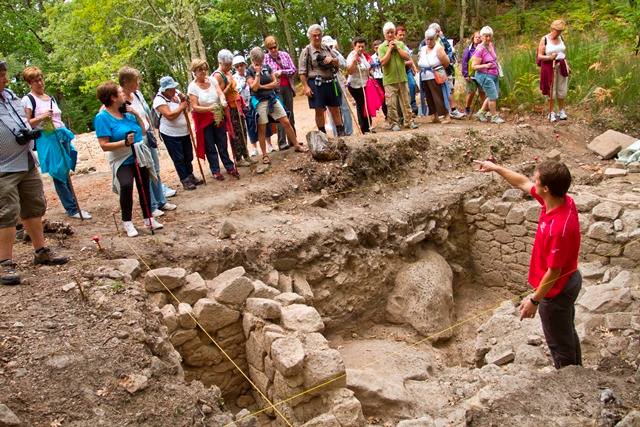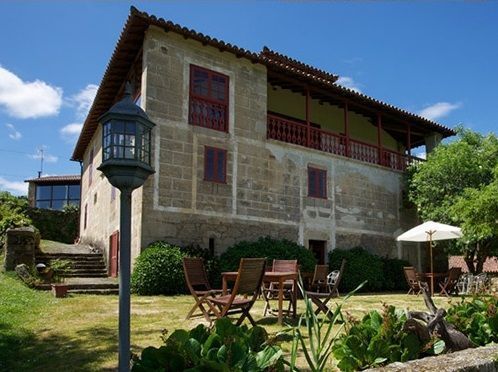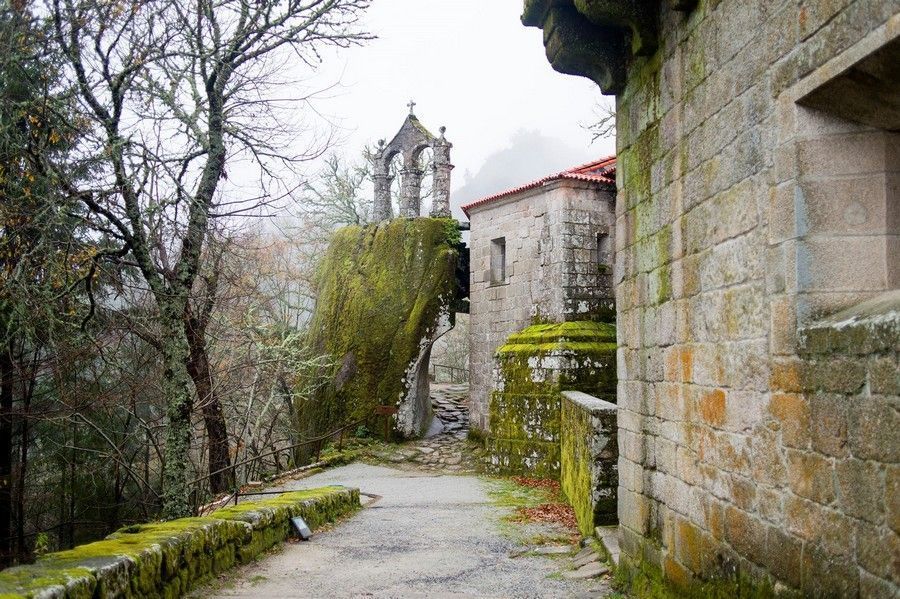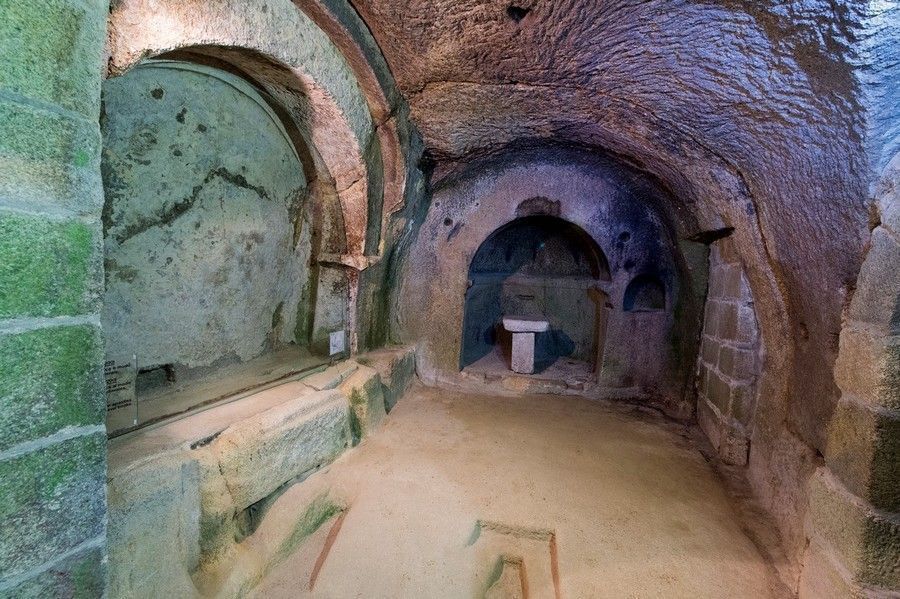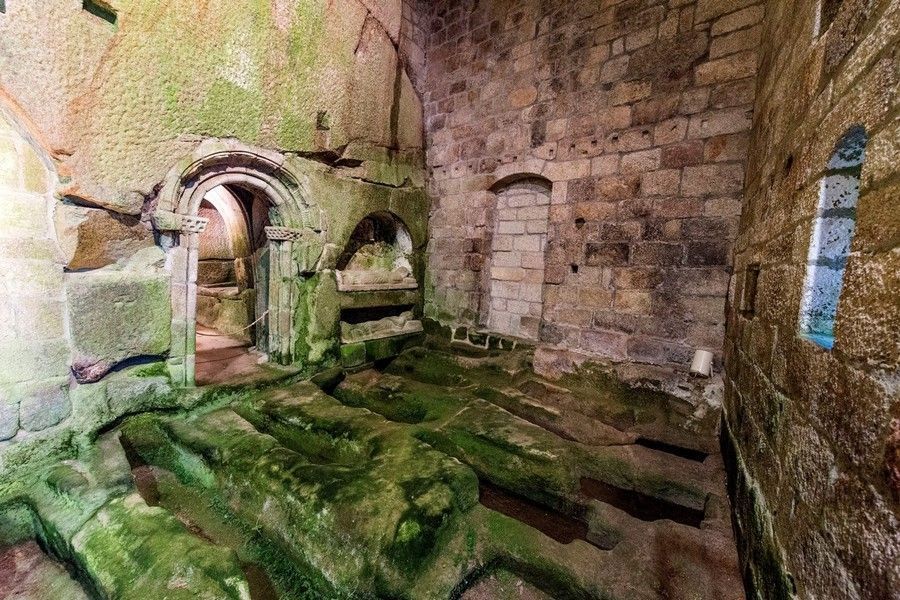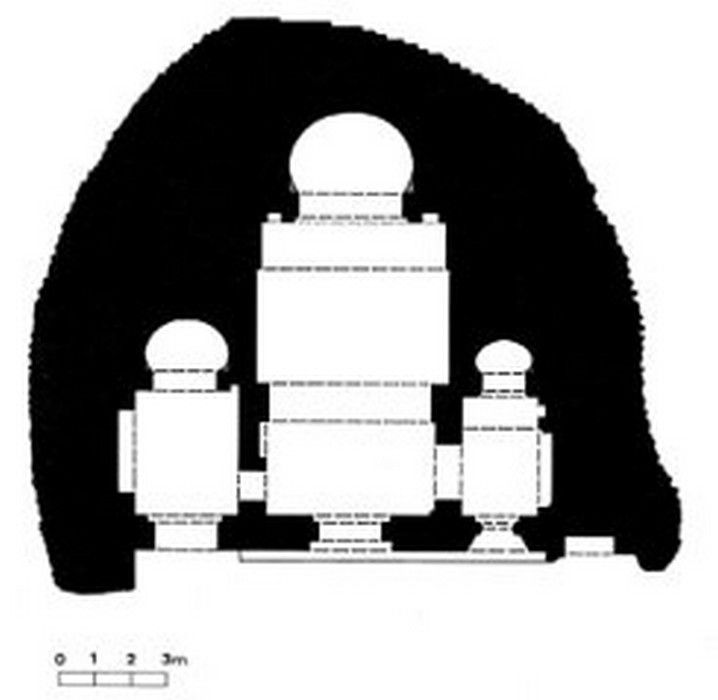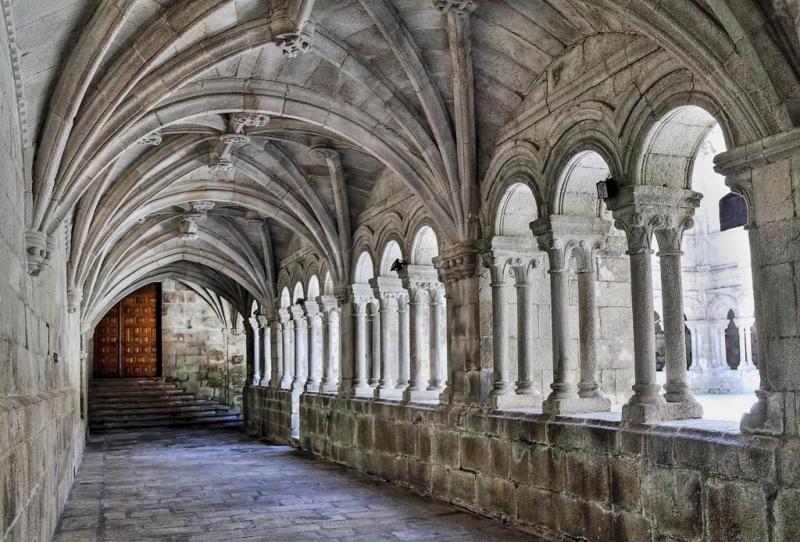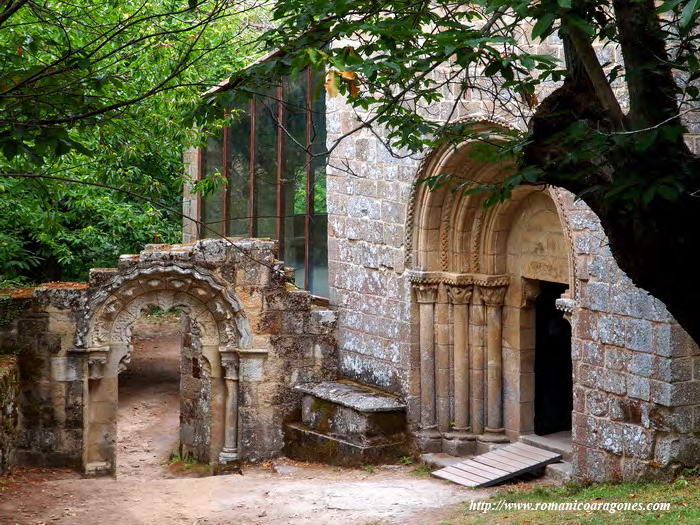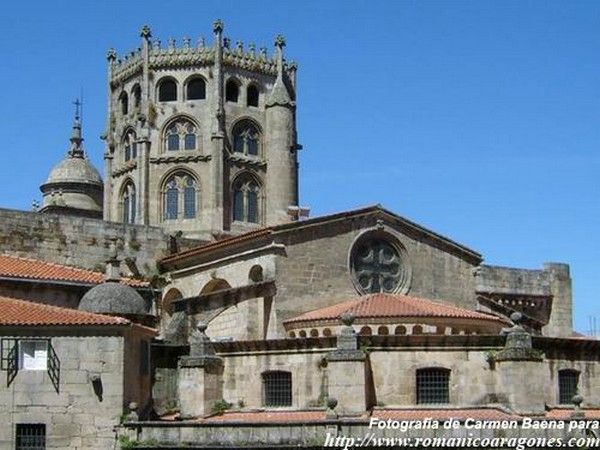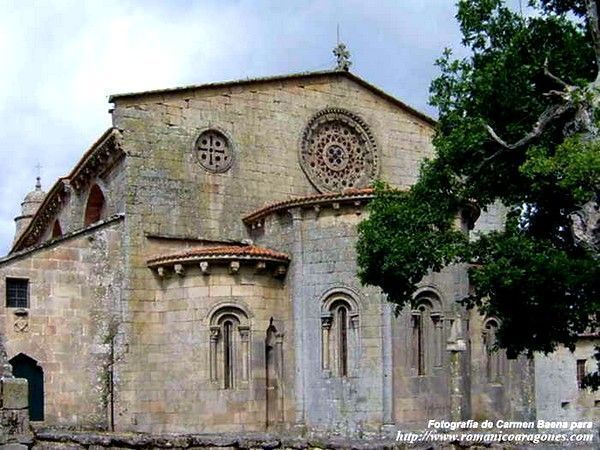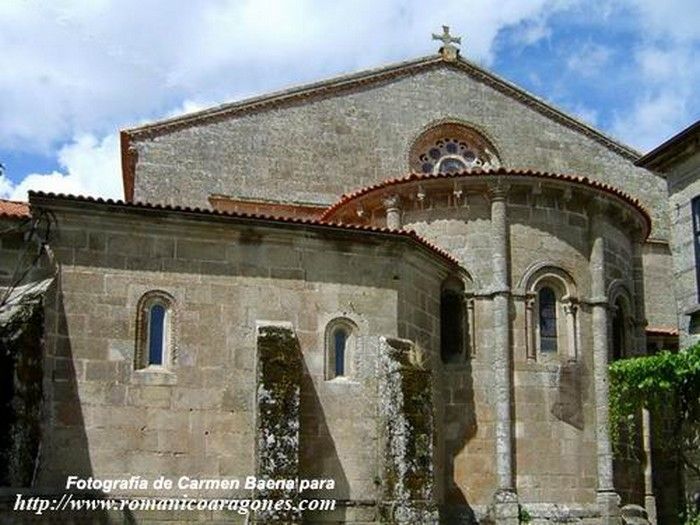SAN PEDRO DE ROCAS
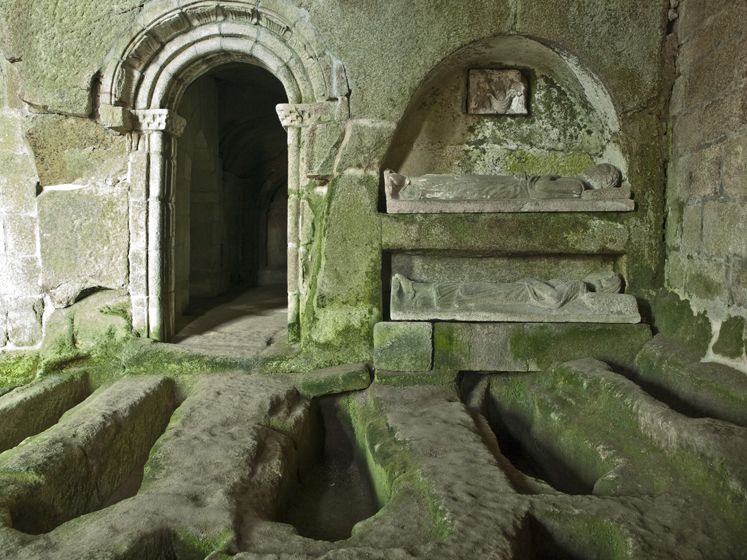
Historic environment
The church of San Pedro de Rocas is located in the municipality of Esgos (Ourense), in the heart of the Ribeira Sacra. Its origin as a religious center is linked to a hermitage carved into the rock, and it is considered the most remote evidence of monasticism in Galicia. To access it, you must enter the Interpretation Center, a stone building whose façade dates from the 19th century.
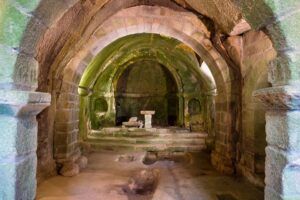 The date of foundation of the hermitage is in the year 573, a date that appears engraved in an inscription or epigraph known as “foundation stone”, which is kept in the Archaeological Museum Ourense province. Although this date has given rise to some debate among specialists, the existence of the monastic settlement at the end of the s is admitted without any discussion. IX, early X, since there is a privilege granted by Alfonso V, dated 1007, which mentions a restoration carried out during the reign of the Asturian monarch, Alfonso III (ca. 886-910).
The date of foundation of the hermitage is in the year 573, a date that appears engraved in an inscription or epigraph known as “foundation stone”, which is kept in the Archaeological Museum Ourense province. Although this date has given rise to some debate among specialists, the existence of the monastic settlement at the end of the s is admitted without any discussion. IX, early X, since there is a privilege granted by Alfonso V, dated 1007, which mentions a restoration carried out during the reign of the Asturian monarch, Alfonso III (ca. 886-910).
After its abandonment during the 8th century, due to the Muslim invasion, it was reoccupied at the end of the 9th century, a process that was also experienced in many other monastic spaces in the Kingdom of León. According to legend, Gemodus, a hunter, discovered the place and decided to settle there to lead a life
lonely in his monastery. Later, in the time of Alfonso V (999-1028), a fire destroyed the monastery. It is in the year 1189 when the monastery and the church were repaired, it was at this time that the extension of the oratories and the disposition of the three naves in the religious enclosure must have been carried out. Thus, between the 12th and 13th centuries, the church acquired the architectural structure that can still be identified today. We must bear in mind that the monumental enclosure of San Pedro de Rocas, the cave monastery, includes several buildings and from different periods: a necropolis, a church with three chapels excavated in the rock itself, an outdoor cemetery, a bell tower erected on a monolith of stone and a building that, at the time, was built as a priory house.
Description
The church -excavated in the rock- is made up, at first glance, of three small naves (which are covered with half-barrel vaults that start from a rough continuous impost) with their corresponding apses -the central one is larger- covered with vaults. quarter sphere. The execution of the access openings to the church was limited for different reasons, among which can be mentioned: the adaptation to a previous hypogeal structure, already existing, the limitations provided by the scarcity of space and the laborious work of excavating in the own rock.
The central nave is larger than the lateral ones, being that of the Epistle (right side) the smallest, and its planimetry corresponds to that of a rectangle in the section of the nave and in its apse a semicircle adapted to a layout previous in horseshoe that was modified. Under the pavement of the nave, five tombs have been discovered, one of them anthropomorphic.
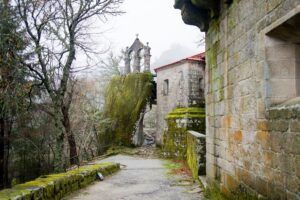 Until the 1980s in the presbytery of the central chapel there was an ara or altar type ‘mensa</i’ >’ with a loculus or hole to house the lypsanoteca or box of relics, which is now kept in the Provincial Archaeological Museum of Ourense. Both from the stylistic and chronological point of view, this piece could be linked to the so-called ‘foundation tablet’. But what of the s. VI or of the ss. IX-X?
Until the 1980s in the presbytery of the central chapel there was an ara or altar type ‘mensa</i’ >’ with a loculus or hole to house the lypsanoteca or box of relics, which is now kept in the Provincial Archaeological Museum of Ourense. Both from the stylistic and chronological point of view, this piece could be linked to the so-called ‘foundation tablet’. But what of the s. VI or of the ss. IX-X?
The nave on the Gospel side -which is smaller in size than the central one- is finished off with a semicircular apse. When the floor of this nave was raised, the existence of two tombs was also verified, one of them anthropomorphic.
The nave on the Epistle side is the smallest, with a smaller surface, with a nave that has a trapezoidal plan and an apse that, as in the case of the south nave, has a semicircular plan. It is considered that this nave was not part of the primitive set and that it is an addition made in the late Romanesque period, well into the 13th century. To his right, carved into the rock, is a set of funerary sculptures, framed by an arcosolium with a semicircular guideline carved into the rock. Two tombs are identified in it, of two recumbent gentlemen in secular clothing, who keep their hands on their chests and have abundant beards. The dating accepted by the researchers is established around 1270, and they wanted to see an influence of the existing tombs in the Royal Pantheon of Santiago de Compostela (1211-1238).
In Romanesque times, a modest cloister must have been located in the immediate vicinity of the southern side of the church, also hosting the cemetery of the monastic community. There is no evidence of their remains since the priory house was built on them.
 With the arrival in Galicia of the Benedictine reform at the end of the 15th century, the church became a parish church and its capacity to accommodate the faithful became insufficient. For this reason, the decision was made to build, in front of the Romanesque façade, a transversal nave known as the “new church”. The transformations of the ecclesiastical complex continued to take place, however the existing data is ambiguous in providing specific dates.
With the arrival in Galicia of the Benedictine reform at the end of the 15th century, the church became a parish church and its capacity to accommodate the faithful became insufficient. For this reason, the decision was made to build, in front of the Romanesque façade, a transversal nave known as the “new church”. The transformations of the ecclesiastical complex continued to take place, however the existing data is ambiguous in providing specific dates.
The true artistic magnitude of this church lies in the conservation of some mural paintings, executed on a surface prepared for the fresco technique, which decorated the northern wall of the Epiphany nave, framed by an arcosolium carved in the rock. They represented a world map of the territories known at that time, with the intention of publicizing the diaspora of the Apostles and the spread of Christian doctrine, following branch I of the manuscripts of the ‘Commentary on the Apocalypse’ made by the Beatus of Liébana in the 8th century.
You can also see the representation of a haloed bust of each apostle in the territory where he proceeded to spread Christianity, with an epigraph next to him to proceed with his identification.
The combination of texts and images is an excellent didactic resource for the correct understanding of the world map. At present, the preserved remains are difficult to perceive and their conservation conditions are precarious.
At present, the dating of this mural painting in the last third of the 12th century is considered valid, and together with the identified remains of the Church of San Martiño (Mondoñedo, Lugo) it represents the most significant pictorial group in the Northwest of the Peninsula. Iberian.
Mónica Blanco para URBS REGIA
Other interesting information
Schedule:
Tuesday to Friday: 10:00-14:00
Saturdays and Sundays: 10:00- 14:00
16:00-19:00
Free entrance.
Bibliography
MALINGRE RODRIGUEZ, A.M., San Pedro de Rocas : un eremitorio rupestre altomedieval, Deputación Provincial de Ourense, Ourense, 1995.
PÉREZ RODRÍGUEZ, F.J. “Mosteiros de Galicia na Idade Media. Guía Histórica (séculos XII-XV). Deputación Provincial de Ourense, 2008.
FERNÁNDEZ CASTIÑEIRAS, E. “Cielo, agua y piedra. La fe sobre la que se construyó la Ribeira Sacra” en Proyecto de Investigación: Encuentros, intercambios y presencias en Galicia entre los siglos XVI y XX, Universidad de Santiago de Compostela, 2011, pp. 313-336.
NÚÑEZ SÁNCHEZ, Mª DEL P., “Altar de San Pedro de Rocas”, IN TEMPORE SUEBORUM. El tiempo de los Suevos en la Gallaecia (411-585). El primer reino medieval de Occidente, Catálogo, Coord., Jorge López Quiroga, Deputación de Ourense, Ed. Armon a Universal, Ourense 2018, pp. 177-178.
LÓPEZ QUIROGA, J. – FIGUEIRAS PIMENTEL, N. “Ecclesia edificata inter alpes roccas nominata. El complejo rupestre de san Pedro de Rocas (Esgos, Ourense)”, IN
TEMPORE SUEBORUM,…, Volumen de Estudios, Ourense 2017pp. 373-394.
Portals




